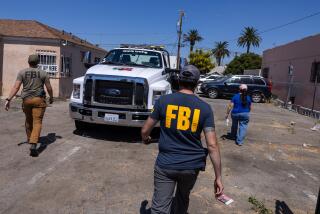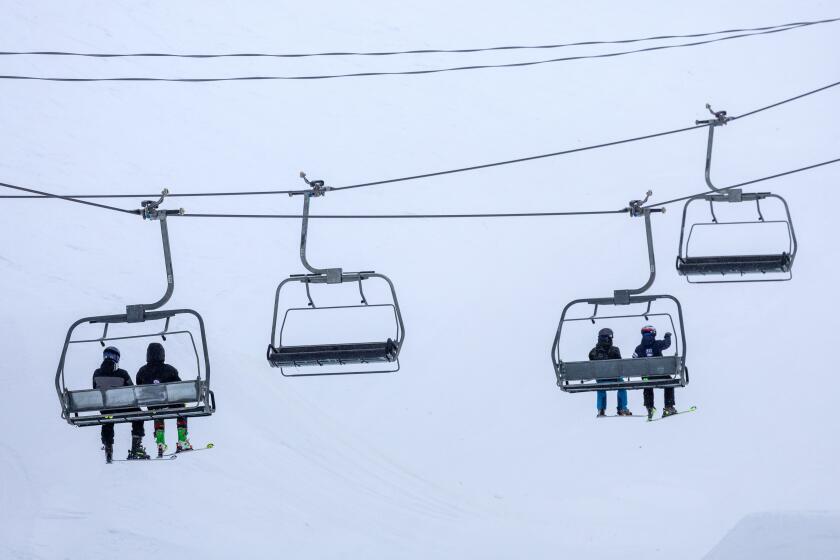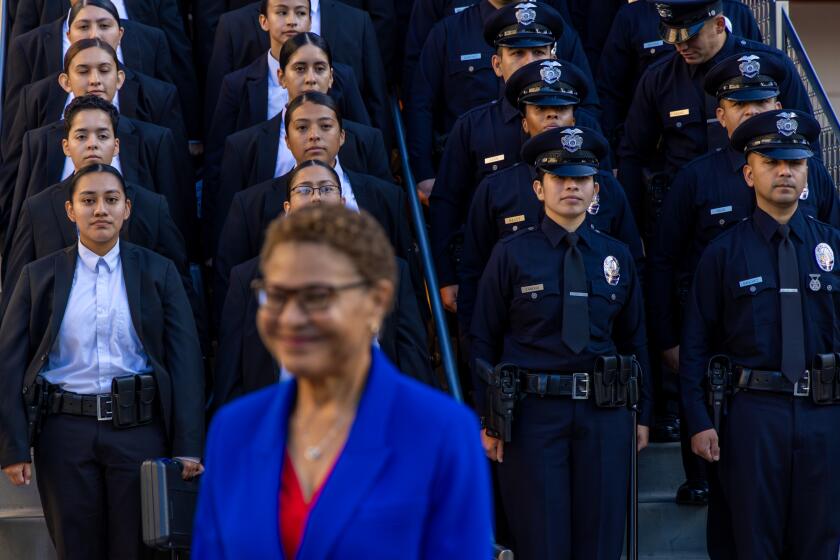Horses, More Dogs to Help Corral Downtown Crime
- Share via
LONG BEACH — Horse patrols and an expanded canine corps will soon join beat cops on foot in downtown Long Beach, as the Police Department revives old techniques in a new strategy to make the rebuilding business district safer.
When the department formally introduces three equine recruits on Tuesday, the first locally since the 1920s, Long Beach will join about 100 police departments nationwide in bringing back the highly visible horse as a crime-fighting and public relations tool.
The three mounted officers probably will draw the most attention. But they are just part of a plan to increase patrols in the downtown, an area that has drawn $1.5 billion in new development since 1975 but remains among the highest crime districts in the city.
Within the last three weeks, seven patrol officers with police dogs also have begun to spend part of their shifts on the same three-by-seven-block beat. And another four canine patrols will be added soon, said patrol Lt. Robert Forbes.
An officer has walked the same beat--bounded by Ocean Boulevard, Pacific Avenue, 7th Street and Long Beach Boulevard--for about two years, he said. And the department expects to assign one or two volunteer reserve officers to the Long Beach Plaza Mall area most days, Forbes said.
The additional officers will supplement the regular patrols by police cars, he said.
Public Perception of Crime
“We basically feel that some types of petty criminals have taken over the area, at least in the perception of the citizens. And we’re going to take it back,” said Deputy Chief Gene Brizzolara, head of the Patrol Bureau.
“Our downtown business district is perceived as being crime-ridden . . . (but) we’re going to give citizens the feeling of security they need to come down there and do some shopping,” he said.
Standing tall above traffic and prominent along the northern Promenade, the spine of the downtown redevelopment zone, the mounted officers will move transients along and “will cause people to take note that there is an on-going patrol in that area,” Brizzolara said.
“People just love to see officers working with our dogs, and we anticipate that will happen even more with the horses,” he said.
The overall strategy is working even before the horses arrive, according to some downtown businessmen, who for years have asked that police officers make themselves more visible.
“There has been a change in the last month with the (canine) patrols, and I think we’re already seeing more business,” said Loren Brown, chairman of the 1,500-member Downtown Long Beach Associates.
Brown said new Police Chief Lawrence Binkley, a Los Angeles Police Department commander until he came here March 1, has done everything he promised in an early April meeting with the downtown business group.
Councilman Evan Anderson Braude, whose 1st District includes the downtown, said he is surprised at the speed with which Binkley has responded to requests to get officers out of their black-and-whites and in more direct contact with the public.
“A number of downtown business leaders have also been pushing it,” Braude said. “If we want this renaissance to continue in the downtown, we must make the appearance of safety a high priority.”
Other Districts Want Their Share
Other City Council members said they like the idea of horse patrols. But they said they would make sure that their districts also get mounted patrols--or other types of police help--if the three-month trial program becomes a fixture downtown.
“My assumption is that the horses in the downtown area will be more of a precedent than an end-all. The chief indicated . . . that he is looking at horse patrols on the beach,” said Councilwoman Jan Hall, whose 3rd District fronts the ocean.
Mayor Ernie Kell, whose 5th District includes El Dorado Park, the city’s largest, said he will be “looking closely to see that the beefed-up patrols will affect all of the city eventually . . . . Just doing it in one area would not sit well with the council.”
However, with the city facing its tightest budget in a decade and the prospect of few additional police hires, questions remain about the practicality of a broader use of horse patrols.
Vehicle patrols cover many miles and frequently respond to calls for help, while mounted patrols cover only a matter of blocks and generally do not respond to such calls, Brizzolara said. “Basically, they’ll be performing very limited duties . . . therefore they are much more expensive,” he said.
Still, the trial program will cost the city little except for manpower and new uniforms. The horses are owned by officers James Williams, David Duskin and Melissa Bray Riddle, who will feed and care for them. A local riding center will stable them for free, Brizzolara said.
Mounted patrols have become increasingly popular with big-city police departments both in California and across the nation in recent years. They are seen as particularly effective in deterring street crime, controlling crowds and building a better public image.
San Jose, Oakland, San Diego and Los Angeles have established regular mounted patrols and San Francisco has had one since the 1870s. Orange County has a horse patrol, and Los Angeles County has its large volunteer mounted posse.
Last fall, the Community Redevelopment Agency in Los Angeles agreed to pay for a mounted patrol downtown in an attempt to curb illegal drug activity.
Feeling of Safety
In Long Beach, Roger Anderman, executive director of the Redevelopment Agency, said the mounted patrols will help make people feel safer. But the downtown has just started its transformation into the planned “18-hour activity environment” that will draw people after dark, he said.
“It has begun to change slowly. We now have a jazz club and a few more restaurants,” Anderman said. And the Ramada Renaissance Hotel on the Promenade at Ocean Boulevard has helped, but there are still few evening activities except south of Ocean at the Convention Center, the Hyatt Regency Hotel and Shoreline Village, he said.
A Sheraton hotel is under construction on Ocean, and developers of a giant International Plaza that would bring shops and theaters to the Promenade have won a court battle and have been directed by the city to move forward, Anderman said. A decision on what to do with the vacant Sears site east of the mall also should be made this year, he said.
Highest Crime District
Reported major crimes in the downtown 1st District remained much higher than in any other council district last year, jumping from 6,740 offenses to 7,715.
City officials frequently say that most of that crime occurred not in the immediate downtown but north and west of it--in low-income residential areas between 7th and Anaheim streets and near the Long Beach Freeway.
But detailed Police Department statistics for 1986 show that the immediate downtown is a high-crime district as well. For example, a two-by-three-block section adjoining the Plaza Mall had 46 robberies in 1986. That is one less than in 1984, when it had more robberies than any of the city’s other 255 crime-reporting districts.
Even the crime district dominated by the new mall had 42 robberies last year, up from 29 in 1984. That district had more reported crime than any other in the city in 1984, with 998 offenses, and that number increased to 1,054 last year.
More to Read
Sign up for Essential California
The most important California stories and recommendations in your inbox every morning.
You may occasionally receive promotional content from the Los Angeles Times.










